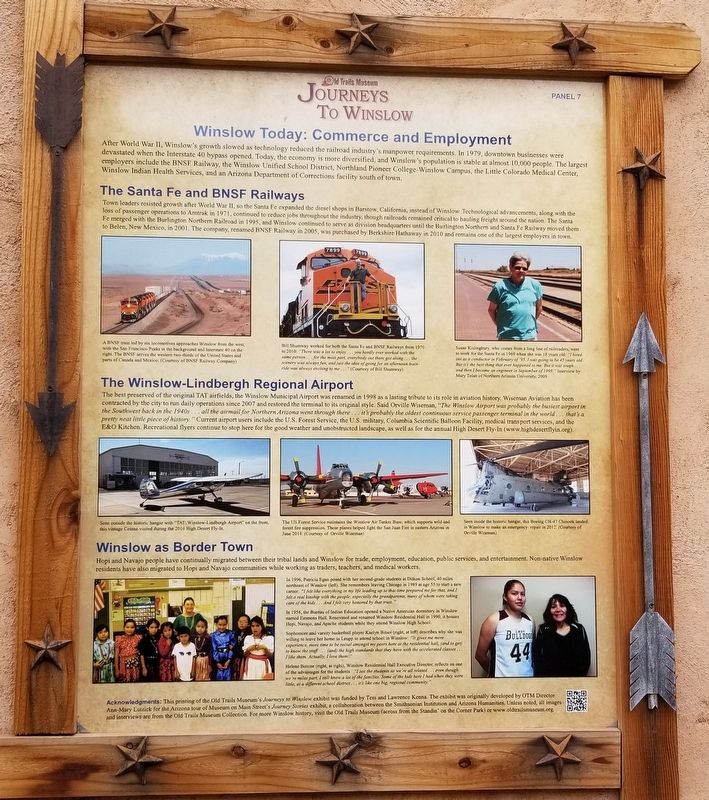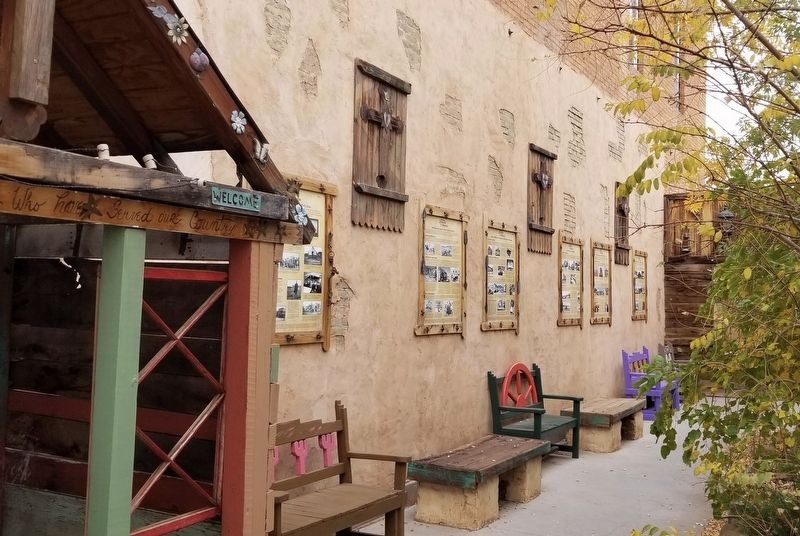Winslow in Navajo County, Arizona — The American Mountains (Southwest)
Winslow Today: Commerce and Employment
Journeys to Winslow
The Santa Fe and BNSF Railways
Town leaders resisted growth after World War II, so the Santa Fe expanded the diesel shops in Barstow, California, instead of Winslow. Technological advancements, along with the loss of passenger operations to Amtrak in 1971, continued to reduce jobs throughout the industry, though railroads remained critical to hauling freight around the nation. The Santa Fe merged with the Burlington Northern Railroad in 1995, and Winslow continued to serve as division headquarters until the Burlington Northern and Santa Fe Railway moved them to Belen, New Mexico, in 2001. The company, renamed BNSF Railway in 2005, was purchased by Berkshire Hathaway in 2010 and remains one of the largest employers in town.
The Winslow-Lindbergh Regional Airport
The best preserved of the original TAT airfields, the Winslow Municipal Airport was renamed in 1998 as a lasting tribute to its role in aviation history. Wiseman Aviation has been contracted by the city to run daily operations since 2007 and restored the terminal to its original style. Said Orville Wiseman, "The Winslow Airport was probably the busiest airport in the Southwest back in the 1940s... all the airmail for Northern Arizona went through there... it's probably the oldest continuous service passenger terminal in the world... that's a pretty neat little piece of history." Current airport users include the U.S. Forest Service, the U.S. military, Columbia Scientific Balloon Facility, medical transport services, and the E&O Kitchen. Recreational flyers continue to stop here for the good weather and unobstructed landscape, as well as for the annual High Desert Fly-In (www.highdesertflyin.org).
Winslow as Border Town
Hopi and Navajo people have continually migrated between their tribal lands and Winslow for trade, employment, education, public services, and entertainment. Non-native Winslow residents have also migrated to Hopi and Navajo communities while working as traders, teachers, and medical workers.
Captions
Upper Left: A BNSF train led by six locomotives approaches Winslow from the west,
with the San Francisco Peaks in the background and Interstate 40 on the right. The BNSF serves the western two-thirds of the United States and parts of Canada and Mexico. (Courtesy of BNSF Railway Company)
Upper Middle: Bill Shumway worked for both the Santa Fe and BNSF Railways from 1970 to 2010: "There was a lot to enjoy... you hardly ever worked with the same person... for the most part, everybody out there got along... the scenery was always fun, and just the idea of going for an afternoon train-ride was always exciting to me..." (Courtesy of Bill Shumway)
Upper Right: Susan Kislingbury, who comes from a long line of railroaders, went to work for the Santa Fe in 1969 when she was 18 years old: "I hired out as a conductor in February of '95. I was going to be 45 years old. But it's the best thing that ever happened to me. But it was tough... and then I became an engineer in September of 1998." Interview by Mary Tolan of Northern Arizona University, 2009
Middle Left: Seen outside the historic hangar with "TAT: Winslow-Lindbergh Airport" on the front, this vintage Cessna visited during the 2016 High Desert Fly-In.
Center: The US Forest Service maintains the Winslow Air Tanker Base, which supports wild and forest fire suppression. These planes helped fight the San Juan Fire in eastern Arizona in June 2014. (Courtesy of Orville Wiseman)
Middle Right: Seen inside the historic hangar, this Boeing CH-47 Chinook landed in Winslow to make an emergency repair in 2012. (Courtesy of Orville Wiseman)
Lower Middle: In 1996, Patricia Egan posed with her second-grade students at Dilkon School, 40 miles northeast of Winslow (left). She remembers leaving Chicago in 1989 at age 55 to start a new career. "I felt like everything in my life leading up to that time prepared me for that, and I felt a real kinship with the people, especially the grandparents, many of whom were taking care of the kids... And I felt very honored by that trust."
In 1956, the Bureau of Indian Education opened a Native American dormitory in Winslow named Emmons Hall. Renovated and renamed Winslow Residential Hall in 1990, it houses Hopi, Navajo, and Apache students while they attend Winslow High School.
Sophomore and varsity basketball player Kaelyn Bitsoi (right, at left) describes why she was willing to leave her home in Leupp to attend school in Winslow: "It gives me more experience, more time to be social amongst my peers here at the residential hall, (and to get) to know the staff... (and) the high standards that they have with the accelerated classes... I like them. Actually, I love them!"
Helene Botone (right, at right), Winslow Residential Hall Executive Director, reflects on one of the advantages for the students: "I see the students as we're all related even though we're miles part, I still know a lot of the familles. Some of the kids here I had when they were little, at a different school district. it's like one big, regional community.
Acknowledgments: This printing of the Old Trails Museum's Journeys to Winslow exhibit was funded by Tess and Lawrence Kenna. The exhibit was originally developed by OTM Director Ann-Mary Lutzick for the Arizona tour of Museum on Main Street's Journey Stories exhibit, a collaboration between the Smithsonian Institution and Arizona Humanities. Unless noted, all images and interviews are from the Old Trails Museum Collection. For more Winslow history, visit the Old Trails Museum (across from the Standin' on the Corner Park) or www.oldtrailsmuseum.org.
Erected 2017 by Old Trails Museum - Winslow Historical Society. (Marker Number 7.)
Topics. This historical marker is listed in these topic lists: Air & Space • Native Americans • Railroads & Streetcars. A significant historical year for this entry is 1979.
Location. 35° 1.397′ N, 110° 41.841′ W. Marker is in Winslow, Arizona, in Navajo County. Marker is on East 2nd Street, 0.1 miles east of North Kinsley Ave. The marker is located in an alley way between two buildings next to the Worlds Smallest Church. Touch for map. Marker is at or near this postal address: 116 E 2nd St, Winslow AZ 86047, United States of America. Touch for directions.
Other nearby markers. At least 8 other markers are within walking distance of this marker. A City in Motion: Modern Modes (here, next to this marker); Winslow Today: Downtown Renaissance and Tourism (here, next to this marker); A City in Motion: The Heyday of the Santa Fe Railway (here, next to this marker); The Railroads Build a Town: Early Industry (here, next to this marker); The Railroads Build a Town: Early Days (a few steps from this marker); The First Peoples of the Southwestern Colorado Plateau (a few steps from this marker); Early Trails Across the Little Colorado River Valley (a few steps from this marker); Standin’ on the Corner Park, Winslow, Arizona (within shouting distance of this marker). Touch for a list and map of all markers in Winslow.
Also see . . . Journeys to Winslow. Old Trails Museum - Winslow Historical Society
The Old Trails Museum debuted the Journeys to Winslow exhibit in October 2017 in the Skylark Courtyard, which is a stop along the Journey Through Winslow Pathway. Developed by Tess and Lawrence Kenna, the Pathway is a trail for residents and visitors to explore Winslow’s history and current downtown revitalization, and its other stops include the World’s Smallest Church on Route 66 and historic facades and murals throughout the downtown historic district. The Kennas funded the reprinting of Journeys to Winslow, which was originally developed by the Old Trails Museum for the Winslow stop on the Arizona tour of the Smithsonian’s Journey Stories exhibition (above at the Grand Opening at La Posada Hotel in June 2013).(Submitted on January 15, 2024, by James Hulse of Medina, Texas.)
Credits. This page was last revised on January 15, 2024. It was originally submitted on January 14, 2024, by James Hulse of Medina, Texas. This page has been viewed 51 times since then. Photos: 1, 2. submitted on January 15, 2024, by James Hulse of Medina, Texas.

